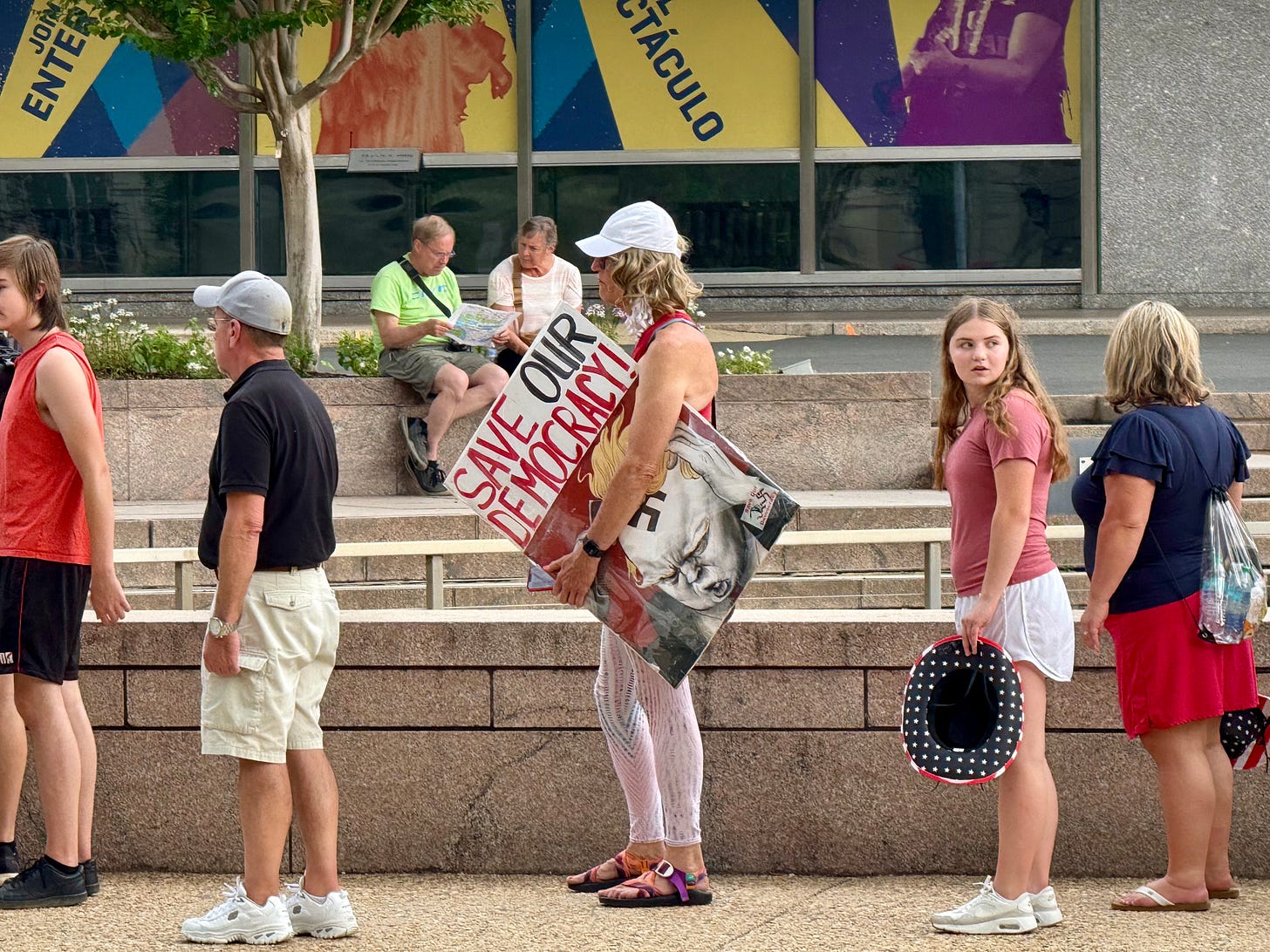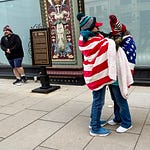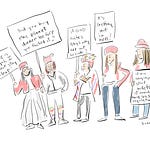Hi everyone. While millions of people joined No Kings protests across the country on Saturday, I took the pulse of folks lining up for a military parade on the 250th anniversary of the founding of the U.S. army, which coincided with President Trump’s 79th birthday. Above you’ll find my livestream and below, you’ll find a time code guide to the broadcast as well as reported reflections on what unfolded.
Thanks to all who joined the broadcast. It’s always a delight to see folks pouring in. It’s also heartening when people spend time with my reporting and observations and decide to upgrade their subscription to paid. I appreciate you recognizing the time, energy and emotional, intellectual and physical labor that goes into this.
I work without the institutional scaffolding that typically supports this kind of journalism — no legal counsel, no fact-checking teams, no employer-provided safety net or health care. Your support becomes an investment in dual recovery: sustaining both the health of independent reporting and the health of our democratic discourse itself. If you can't pay for your subscription, please pay it forward. Like, share, restack, comment, shout from the rooftops that you think the way this Substack, Invisible Threads, reveals the ties between mental health and democracy is a vital part of the healing we need.
Time Code Guide to the Livestream
0:00-2:31 - Opening scene description
2:25-03:49 - Personal reflection on mental health
3:49-5:38 - Crowd analysis, collective nervous system
6:09-11:40 - I run into my old colleague Erik Wemple, The Washington Post Opinion’s media critic. It’s a fun exchange, and I ask him not only about what he’s seen at the parade but about the controversy surrounding The Post and its owner Jeff Bezos that prompted hundreds of thousands of people to cancel their subscription.
13:49-17:47 - I talk to a father and son from Warrenton, Virginia about why they came out to “honor the brave men and women of our army.” As Dave said, “You can see the protesters over here. I mean, I may not necessarily agree with them, but that's what our country's about, you know, and it's pretty awesome to be able to come down here, my son, to see people of all stripes, you know, people we don't agree with, people we agree with, all in one spot safely, you know, and that's what's really cool to do. That's what our military did. That's what our country was founded on.”
25:50-38:03 - I chat with Kathleen & Carl Frank from Bowie, Maryland. This was an interesting exchange where Carl and I shared different perspectives that got a bit animated. I then checked in with him about his stress level, shared mine, and we were able to notice some tension and find a calmer footing to explore what assumptions were being made and where we might find common ground.
Fact check:
In this exchange, Carl compares Vice President Al Gore's legal challenge to the 2000 election results with President Trump's response to his 2020 electoral loss. These situations are not equivalent. Gore requested a manual recount of Florida votes—a standard legal remedy that the U.S. Supreme Court ultimately rejected. When the Court ruled against him, Gore immediately conceded and certified the election results, handing the White House to George W. Bush. Trump, by contrast, filed 62 lawsuits challenging his loss, with 61 failing in court. Rather than conceding, Trump urged supporters to march to the Capitol and "fight like hell," never accepted the 2020 results, and refused to attend Biden's inauguration — actions that culminated in an armed attack on the U.S. Capitol aimed at overturning the election.
Also in the exchange, Kathleen claims that President Trump tried to deploy the National Guard to the U.S. Capitol on Jan. 6, but former House Speaker Nancy Pelosi and D.C. Mayor Muriel Bowser blocked the security support. This is false. While Trump had approved the potential activation of the D.C. National Guard days before Jan. 6, he also told his supporters to march to the Capitol that day. When rioters began attacking the building, both Pelosi and Senate Majority Leader Chuck Schumer urgently appealed for National Guard deployment to stop the violence. The significant delays in getting troops to the scene resulted from miscommunication and poor coordination between military and law enforcement agencies — not from Pelosi or Bowser blocking their deployment.
18:53-21:17 - I summarize some of the Constitutional violations that judges have ruled against Trump for, or that are being litigated.
41:20-44:01 - I explain my personal stress response to the scene.
46:47-49:06 - I give a very brief description of the Polyvagal Theory of how the autonomic nervous system responds to perceived threats, influencing our social behavior, emotions and stress.
00:52:05-00:54:46) - Closing thoughts
Reported Reflections
The military parade that President Trump ordered on the 250th anniversary of the U.S. Army, which fell on his 79th birthday, was made for TV — as long as the director kept a tight shot on the tanks. Widening the lens, I saw as much dissent against the president and disgust over the parade as I heard support for both.
The fence surrounding the White House turned into a gallery of protest signs. The blocks-long line to enter the security perimeter for the parade was a mix of people wearing Army shirts, MAGA hats and anti-fascism signs.
As hectic as the streets were around the parade route, D.C. was unusually quiet. The National Mall, adorned with tanks and rocket propelled grenade launchers available for photo ops, had far fewer visitors than typically come out for the 4th of July or the Smithsonian Folklife Festival. The nearly 7,000 troops in the parade, which the Army said could cost as much as $45 million, far outnumbered the people trying to see them.
Why? One reason is that the center of gravity of American civic engagement Saturday was dispersed across 2,000 cities. Millions of people marched at “No Kings” rallies protesting Trump’s disregard for laws and the Constitution, abuses of power and brutal immigration raids.
As cartoonist
reported from New York City, the march there was “incredibly inspiring,” a sentiment I heard from people across the country. “We pulled off an energetic, meaningful, friendly, peaceful, music-filled, committed protest against Trump today.”Protesters are not imagining their concerns. Bright Line Watch, a benchmark survey of more than 700 political scientists, found that the majority surveyed think the United States is moving quickly from liberal democracy toward some kind of authoritarianism. The survey echos the concerns of Freedom House, which has measured an 11-point decline in U.S. democracy over the past decade on a 100-point scale. The fact that protests were allowed to take place — including around the military parade — is a testament that we still have freedom worth fighting for.
Another reason the military parade may not have pulled a larger crowd is the host himself. Trump has politicized the military, deploying members of the National Guard and Marines to crush protests in Los Angeles against the California governor’s wishes. This has happened a few times in U.S. history, but generally to support Americans’ civil rights when the state governor was not upholding them. A federal judge ruled last week that Trump’s domestic use of the military violated the law, but the 9th U.S. Circuit Court of Appeals blocked his orders to return the National Guard to the California governor’s control, pending a hearing next week.
Trump is actively working to use the military to support his personal persuasions. In a recent speech at Fort Bragg, soldiers pre-screened for their allegiance and appearance (“No fat soldiers”) cheered as Trump verbally attacked his political opponents, including former President Biden. As retired General Stanley McCrystal pointed out in a recent PBS interview, the armed forces swear an oath to the Constitution, not to the political leader in the White House. The assumption is that the commander in chief will respect the Constitution, but when they don’t, they can force moral injury upon America’s men and women in uniform.
“This has been a bad week for the Army for anyone who cares about us being a neutral institution,” a Fort Bragg commander told Military.com on the condition of anonymity to avoid retaliation. “This was shameful. I don’t expect anything to come out of it, but I hope maybe we can learn from it long term.”
In D.C., many of the people I talked to in line for the military parade said they were there to support freedom, democracy and the Constitution and they didn’t have any concerns with Trump’s actions. You can watch the exchanges I had on camera in the video at the top of this page. Off camera, I found more nuanced reflections where people admitted they’re grappling with what they thought Trump would bring versus what is unfolding.
Many of my readers say it helps to see me model civil discourse, and some have suggested that for liberals who don’t normally talk to Trump supporters, it’s a kind of exposure therapy. More of this, please. The stakes are high, and the bar is low.
This past week, federal agents pushed California Democratic Senator Alex Padilla to the ground and handcuffed him after he tried to ask Homeland Security Secretary Kristi Noem a question at a press conference. And as Americans were preparing to rally Saturday morning, news broke that former Minnesota Democratic House Speaker Melissa Hortman and her husband, Mark, were killed by a lone gunman in what appears to be a politically motivated shooting.
We can’t heal this nation if we are dehumanizing each other, let alone not talking to each other. I hope these conversations are helpful.















Share this post